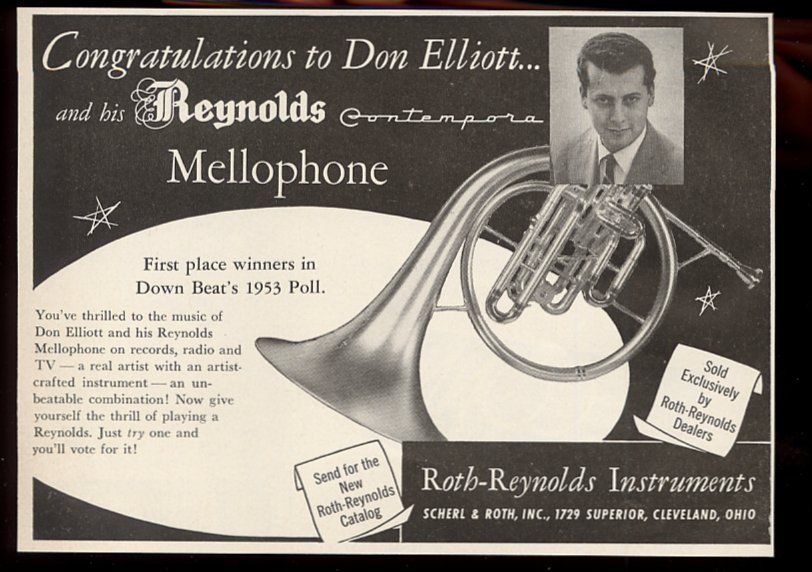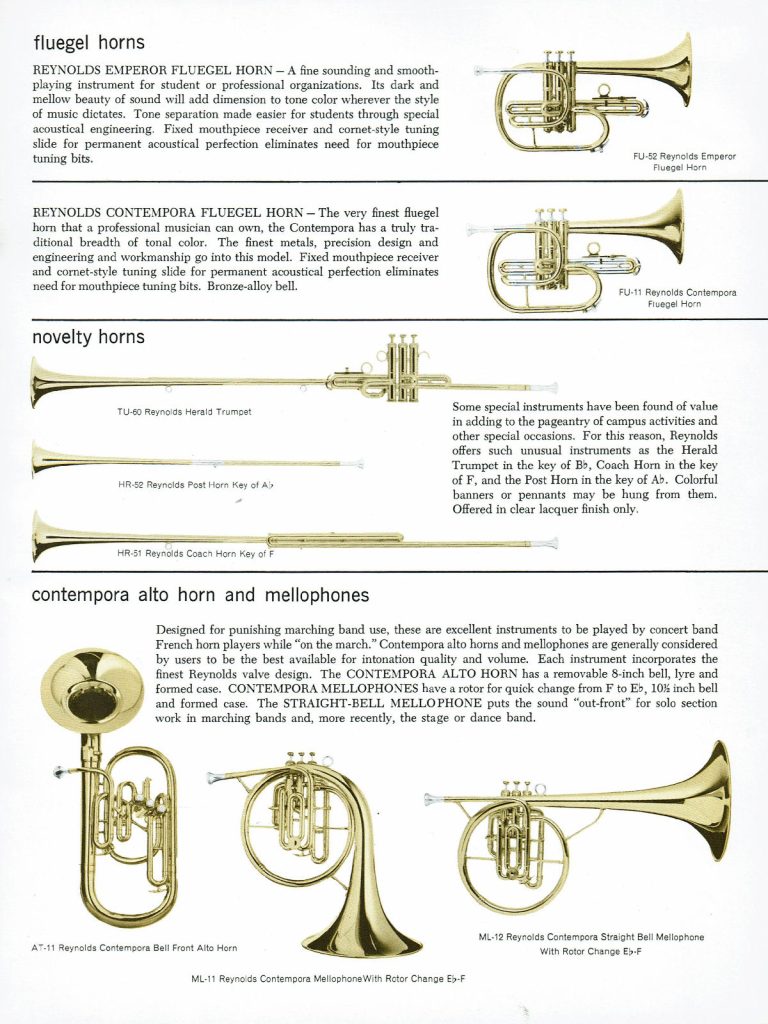
The traditional mellophone provided trumpet and cornet players with a piston-valve option for alto voice parts, while bell-front or marching versions gave French horn players an option on the marching field.
1936-c.1950
Ohio Band Instrument Co. (Cleveland, Ohio)
Regent instruments were made by Ohio Band Instrument Co., a subsidiary of F.A. Reynolds, using the same factory machines and craftsmen as the parent company.
This instrument is built in F and E♭, so it can be used in either band or orchestra. It is designed to give a more melodious tone, very much like that of the French Horn quality. This mellophone is constructed so as to make it easy to hold and play in either marching or seated formation. Ideally suited for beginners in band playing. Good intonation through the entire scale.
World War II
Throughout the 1940s, F.A. Reynolds Co. was awarded contracts by the U.S. Army Quartermaster for band instruments, becoming "a major source of supply for the Armed Forces during World War II." [1977 catalog] These instruments have a silverplate finish with unique engraving and a large "U.S." mark near the rim of the bell. Known serial numbers date production from between 1940 and 1952.
These contracts allowed the relatively new company to continue focusing on making band instruments when more-established manufacturers, e.g., F.E. Olds and Conn, were forced to shut down instrument lines and produce wartime equipment. Details of the contracts are not available, and it is not specified which service bands received the instruments, though anecdotal evidence suggests that the bands of the U.S. Army Air Forces (USAAF) may have been recipients, having just organized in 1941.
1946-1952
F.A. Reynolds, division of Scherl & Roth (Cleveland, Ohio)
The Contempora line launched in 1949 with new trumpet and bass trombone models, followed by cornet and tenor trombone. A year later, most original "F.A. Reynolds" instruments had been rebranded on paper as "Contempora" instruments, including the Alto Horns, though they were still referred to as "Reynolds" instruments throughout the 1950s. It is undetermined if the "Contempora" name was engraved prior to 1952, so many of these instruments may look the same as the F.A. Reynolds models.
By 1949, the Reynolds Mellophone had been upgraded with the addition of a rotary valve that enabled the player to switch to E♭ tuning, rather than have to switch tuning crooks on the horn.
The Reynolds Mellophone is tuned to F with rotary quick change to E♭, which makes it readily adaptable to both orchestra and band without transposition. With its rich, full, mellow tone, it often substitutes for the French Horn and has a lush, velvety quality that blends beautifully with other band and orchestral instruments.
1952-1961
Roth-Reynolds (Cleveland, Ohio)
Mellophones made from 1952-1960 should have "Contempora" and "Made by Roth-Reynolds" engraved on the bell.
Built in F with rotary quick change to Eb, which makes it readily adaptable to both orchestra and band without transposition. With its rich, full, mellow tone, it often substitutes for the French horn and has a smooth velvety quality that blends beautifully in ensemble playing. Available in three finishes, all prices complete with case and accessories.
1961-1964
RMC/Reynolds (Cleveland, Ohio)
Sometime after Richards Music purchased Reynolds in 1961, the product catalog was reorganized. Old model numbers were replaced with a new scheme that incorporated an abbreviation for the type of instrument, e.g. "ML" for Mellophone, and a hierarchal numbering system that reflected the grade of instrument, e.g. "01" for top-level artist instruments, "56" for student horns. To the best of knowledge, the instrument specifications did not change, just the model numbers. The new numbering system was used for the rest of the company's history.
Designed for punishing marching band use, these are excellent instruments to be played by concert band French horn players while "on the march." Contempora alto horns and mellophones are generally considered by users to be the best available for intonation quality and volume. Each instrument incorporates the finest Reynolds valve design.
Model ML-12
Reynolds Straight Bell Mellophone in F/E♭
Bore: TBD
Bell: 10½"
Valves: three piston valves with rotary change valve from F to E♭
Materials: brass with nickel-silver valve caps, and trim
Finish: polished brass with baked epoxy finish
Notes: Conn's version of the straight-bell mellophone, the mellophonium, is particularly known for its use by the Stan Kenton Orchestra in the early 1960s. It's not known if Richards tried to build on that publicity by introducing model ML-12, but the reference to "the out-front sound in ... the stage or dance band" in the catalog description is in this context.
1964-1970
Reynolds (Fullerton, Calif.; Abilene, Texas)
After CMI purchased the assets to Reynolds, background and low brass instruments were produced at the Reynolds factory in Abilene, Texas. There were slight adjustments to the model specifications compared to the Cleveland instruments.
Known for having the best intonation quality and volume, these Reynolds background instruments please bandsmen with their big, satisfying sound. Even beginners find them effortless, due in large part to Reynolds' precision valve-making and scientific bore design. Each instrument is a beauty in brilliant brass; silver-plate with bright or gold bells optional at slight extra cost.
1970-1979
Reynolds (Fullerton, Calif.)
In 1970, Reynolds merged all production lines with Olds in Fullerton and sold the Abilene plant to Conn. In most cases, a horn would come off the California production line and become either a Reynolds- or Olds-branded instrument based on detailing and finish. Reynolds instruments made in this last decade are engraved "Made in USA".
Reynolds/Olds introduced the Marching Mellophone, ML-13, in 1970, replacing the Straight Bell Mellophone, ML-12, which had served the same use in the catalog. The traditional Mellophone, ML-11, was dropped by the end of 1974.
The compact design and lightweight construction of the Reynolds Marching Mellophone offers superior playing ease and comfort in the most intricate maneuvers. In addition to the improved intonation, the ML-13 responds instantly while retaining richness and balanced clarity of tone throughout the scale. Highly polished brass with a baked epoxy finish. Extra heavy bracing provides the rugged strength required in a marching instrument.
The purpose of this website is to preserve the history of the F. A. Reynolds Company and the distinctive qualities of its brass instruments. Contempora Corner and contemporacorner.com are not related or associated in any way to the former or current F.A. Reynolds Company.
Copyright © 2004-2024 ElShaddai Edwards. All Rights Reserved. Terms of Use.


![Model TBD [SN 23620]. Photo source: Kenny Neal.](https://contemporacorner.com/wp-content/uploads/2009/01/regent_023620.jpg)

![Model 1216 [SN 3851]. Photo source: eBay. Shown with Eb slide attachment.](https://contemporacorner.com/wp-content/uploads/2009/01/regent_003851.jpg)

![Model TBD [SN 4806]. Photo source: Kenny Neal.](https://contemporacorner.com/wp-content/uploads/2009/01/004806.jpg)



![Model 100 [SN 59804]. Photo source: eBay.](https://contemporacorner.com/wp-content/uploads/2009/01/059804.jpg)





